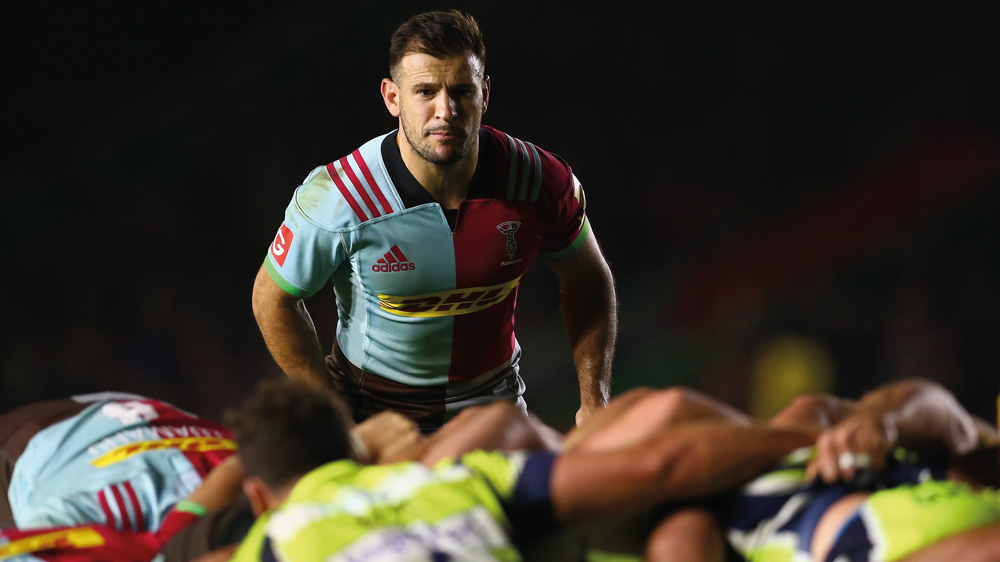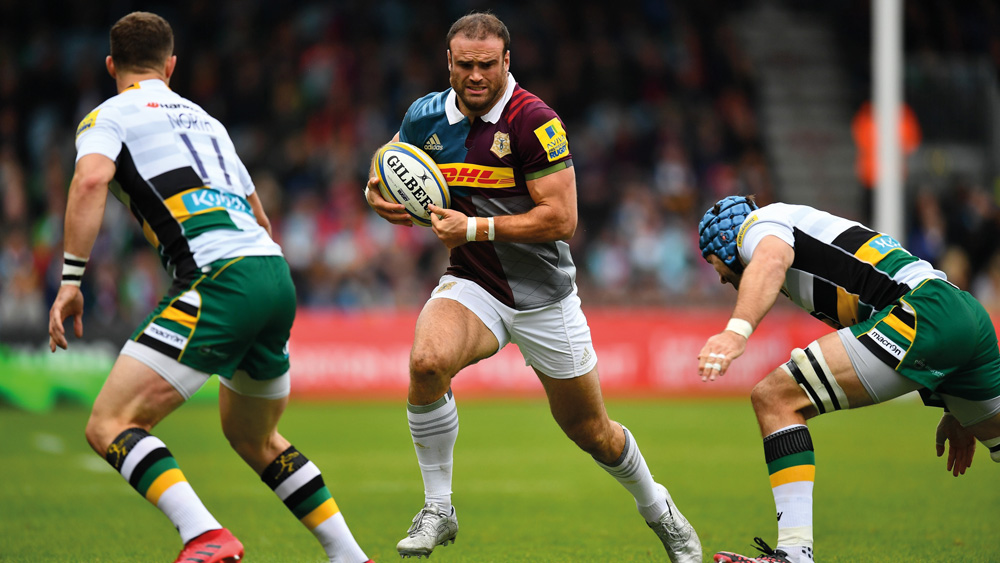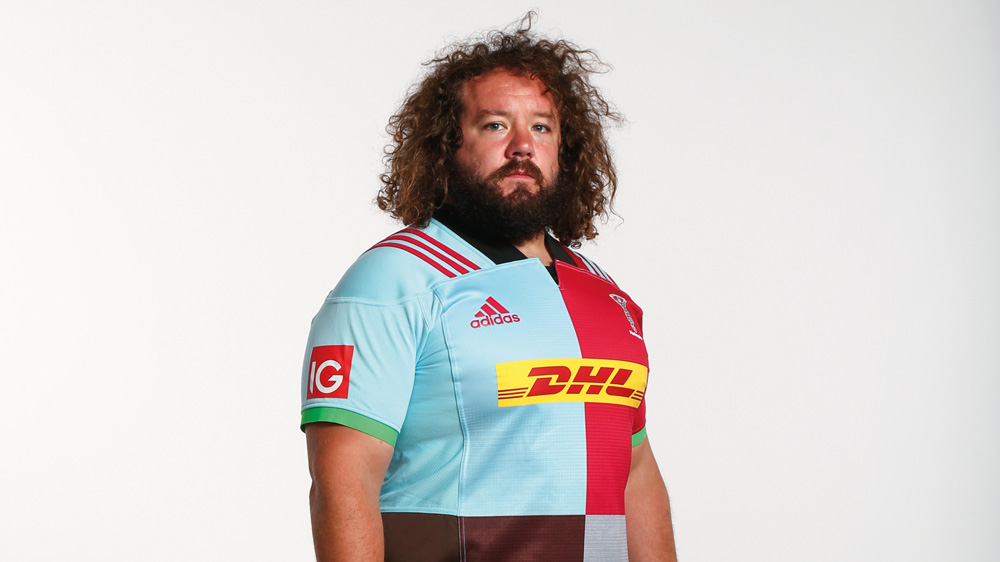The Rugby Training Secrets Of Harlequins’ Danny Care, Jamie Roberts And Adam Jones
Harlequins success starts with their phenomenal training routines. Three Quins reveal the work they do off the field

Photography: Steve Bardens, Dan Mullan
The Playmaker: Danny Care
Scrum-half Danny Care, one of England’s ten most capped players, knows a thing or two about setting smart goals, keeping things simple and looking after your body.
Staying focused
“This year the training’s been stripped down,” says Care. “We’ve focused on the fundamentals – our catching and passing. Normally in preseason we work on speed and power, but this season there’s been a lot of emphasis on flexibility, especially for us older lads [Care is 30]. That allows us to be more explosive in our movements and train at the level we want to train at. Once you get a bit older you have to take more care of your body on your days off. A lot of the lads are doing flotation tanks, stretching classes – but I’ve got a little boy to look after so chasing him around the garden keeps me in decent shape and active.”
Going one-sided
Traditionally, rugby players put up huge squat numbers – but for Care, going unilateral’s paying dividends. “My main lower-body lift at the moment is a weighted reverse lunge,” he says. “It’s good for me to get my hips strong. I’m down on the floor doing a lot of passing movements, so by having a strong groin, hips and glutes I can be explosive from those positions.” It’s also safer: in a study from Seoul National University, forward lunges put more shearing forces on the knee joint, while reverse lunges provided more muscle activation in the quads and glutes.
Mixing and matching
“For my upper-body work I’ve gone away from the barbell bench press a little bit and I’m doing a lot more with dumbbells,” says Care. If you’re aiming for bigger arms, it’s worth doing both – in a 2011 study, doing a one-rep max resulted in more muscle activity in the biceps when volunteers used dumbbells, but more triceps activity with a bar. Whatever you’re doing, make sure you’re pulling as well as pushing: Care uses chest-supported prone rows to keep his back in shape.
Nailing the attitude
“Whatever job you do, you always need the right mindset,” says Care. “Professional sport can be pretty cutthroat and if you haven’t got the right attitude you tend to fall by the wayside. At Quins we set very high standards – even if you don’t meet them, which we haven’t really in the past couple of years, you have to have that win-every-day mindset. Everyone’s different when it comes to setting goals – some lads don’t set any, some set them every day– but mine is to go into work every day with a smile on my face, and when I do that I tend to work hard. You’ve got to remember that you’re doing a job that you love – and then you’ve got to get your head down and work hard.”
Running on instinct
“The best advice I’ve ever been given is to trust the first decision that comes into your head,” says Care. “If you’ve done the right preparation you can afford to back your instincts. You subconsciously assess situations a lot quicker with experience, and at the highest level you haven’t got the time to think everything through. Normally your first instinct is the right one – obviously you’re still going to make mistakes, but as long as you aren’t taking four seconds to make them, you’ll probably get it right more often than not. For me, when I think about the game too much, I overcomplicate it.”
Get the Coach Newsletter
Sign up for workout ideas, training advice, reviews of the latest gear and more.
See related
- Rugby Workout to Get Back in Shape for the Pack
- Get Rugby Fit With This Full-Body Workout
- Lions Forward Maro Itoje’s Leg Workout Looks Suitably Heavy
The Scientist: Jamie Roberts

Welsh centre Jamie Roberts combines his knowledge as a qualified doctor with technology to get past injuries. He explains how players have adapted their training to the modern game.
Doing the hard yards
“This year in preseason I focused a lot of different things: I’ve got a few aches and pains, so I worked on those, but it was also about trying to cover enough distance at high speed,” says Roberts, who obtained his degree in medicine from Cardiff University in 2013. “If you don’t train at a certain intensity it’s very difficult to integrate that into a game. These days we have GPS on every player, so you can look at the figures, see how many metres you’ve done in a training session and how many you did over a certain speed. You can usually tell on your own if you’ve had a tough training session, but if you’re trying to quantify how hard you’ve worked it helps, because the game’s played at 100% speed and you have to be ready for that.” Eliminate junk miles in your own training with a subscription to run tracker Strava – the first month’s free.
Changing with the times
“The game’s certainly got faster in the time I’ve been playing,” says Roberts of the period since he made his Cardiff Blues debut in 2007. “It’s faster, I’m in for more time during the game, there’s less stoppage – and so the training’s adapted to that. The collisions are still as big and powerful but there are probably not as many of them because the ball’s being shifted a bit more now. You’ve got to adapt accordingly, so a lot of my cardio stuff is short, sharp minute repeats to replicate a match. I do the Wattbike, SkiErg or Concept2 for six seconds on and 18 seconds off - in rugby you’re not running for a minute at 75% pace, you’re covering 40 metres in five seconds.” Going short but hard trains the ATP system, your body’s primary source of energy.
Working the mechanics
It’s not all raw power. “I’m doing more running exercises, trying to get a bit more economical and efficient - you don’t want running taking a toll on you 50, 60 minutes into a match,” says Roberts. “I’ve been doing sprint sessions with a coach called Frans Bosch since 2011, working on running mechanics stuff. It’s about making sure you’re efficient so you can go further, faster but feel less tired.”
Bosch teaches his athletes to minimise contact time with the ground and get the back foot off the ground fast. Practise running with a pipe or broom handle across your shoulders: you won’t be able to compensate for body rotation with your arms, so bad mechanics will send you off balance.
Preventing damage
“I do a lot of prehab for my legs,” says Roberts. “A lot of step-ups, a lot of isometric calf and hamstring work. One favourite’s an eccentric hamstring bridge – just lifting the weight and holding it, then lowering slowly. I’ll sit on the leg press and do isometric calf holds, just holding the weight, trying to stay reactive in my calves. I’ve always had a problem with my calves – I can barely walk after the first few sessions of the year – but it comes back quite quickly.”
Roberts know what he’s talking about – in a 2015 review of studies, athletes who skipped doing their eccentric hamstring training were three times more likely to suffer a strain than those who did the work.
Mastering mobility
“Mobility is huge, and being a tall guy I struggle more than the average rugby player,” says Roberts. “I’ve taken more interest in it now I’m over 30. You’re always amazed after you do a few sessions of mobility – I wish I’d done more of it when I was in my 20s, to be honest. I do a lot of movements for my spine and my lower back – my lower back takes a hell of a lot!”
Finishing strong
“I like that quote ‘The more I practise, the luckier I get’,” says Roberts. “You can’t blag it in this game, you have to put the graft in – I sincerely believe that, and you know when you’ve worked hard, and what you deserve to achieve. That’s something that’s in the back of my mind during preseason: you can go to some pretty dark places in your training, but you’re always conscious of whether you’ve gone hard enough.”
You’ll build more than just muscle: American researcher Angela Duckworth notes that the “grit” built by deliberately doing hard workouts makes pushing yourself in other ways easier – especially on game day.
The Veteran: Adam Jones

With 95 Wales caps and three Six Nations Grand Slams under his belt, prop Adam Jones is passing on his considerable wisdom in his new role as player-coach – whether that’s how to build mental strength or watch your weight
Blocking it out
“People who just watch games might not realise what goes on behind the scenes – how much thought goes into the timings of sessions, and organising blocks of training and rest,” says Jones. “There’s a lot to think about – but it has to be done.”
For maximum results, structure your own training in phases: do three to five reps per set for strength work for four weeks, then eight to 12 for a hypertrophy week for another four.
Staying on weight
A less punishing playing schedule doesn’t necessarily mean more rest for Jones. “When I’m playing it’s a bit of a grind to do extra sessions,” he says. “I spend a lot of time on the Wattbike, just making sure I’m prepared and trying to keep the weight down. I might do a 30 seconds on, 30 off session, or I might do a 45-minute grind on level 10, or do the same sort of length with some out-of-the-saddle efforts. It’s a good blowout and a great way to get your legs working. I really enjoy it. It’s hard on the legs but it takes a bit more care of you than some of the impact stuff.” Make sure you rotate in some cardio sessions to leave your joints in better shape.
Pushing and pulling
“If I fit in a session at lunch I’ll get on the Prowler sled,” says Jones. “For my front-row position, that was my main tool when I was at my playing peak. Just going heavy, heavy, heavy – push it 50 metres, pull it back. Depending on what time of the season it is, you might go more short and sharp. If I could push 200kg one day, I’d aim to do more the next week, or do it faster.”
Ignoring the numbers
“I used to deadlift about 270kg,” says Jones. “I had a decent deadlift and bench press before rugby, but then your shoulders and your lower back get wrecked… I do a lot more prehab now.” There’s a lesson there: as long as you’re performing the way you want, there’s no need to obsess over gym numbers.
Forcing habits
“At the top level of the game, you need to train the same way you’re going to play,” says Jones. “Everyone’s got timing and technique at this level. It’s about refining it, making it better, being able to do it when you’re under pressure. You need to train your habits so you’ll react to things the right way. After 70, 80 minutes of a game when you’re fucked, and you’ve got to clear the ball to win the game, it’s about being able to revert back to your coaching. It’s hard to replicate in training, but you have to do it. You’ll only ever be as good as the level of your training.”
Stepping up
“When you go from the academy level to the Premiership or to international level, it’s a massive step up in intensity,” says Jones. “The ball’s in play for a lot more time, for one thing. That means you have to try as hard as you can in training, push yourself that little bit more, replicate that ball-in-play time without smashing each other. A lot of it’s down to you - you’re the one who’s going to notice if you’re resting for a couple more seconds between efforts, and you’re the only one who knows if he’s really put the work in.”
For ticket details for forthcoming Harlequins fixtures go to tickets.quins.co.uk
From 2008 to 2018, Joel worked for Men's Fitness, which predated, and then shared a website with, Coach. Though he spent years running the hills of Bath, he’s since ditched his trainers for a succession of Converse high-tops, since they’re better suited to his love of pulling vans, lifting cars, and hefting logs in a succession of strongman competitions.

